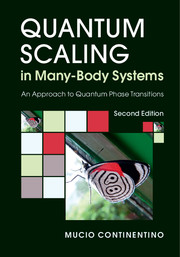Book contents
- Frontmatter
- Dedication
- Contents
- Preface
- 1 Scaling Theory of Quantum Critical Phenomena
- 2 Landau and Gaussian Theories
- 3 Real Space Renormalisation Group Approach
- 4 Renormalisation Group: the ∊-Expansion
- 5 Quantum Phase Transitions
- 6 Heavy Fermions
- 7 A Microscopic Model for Heavy Fermions
- 8 Metal and Superfluid–Insulator Transitions
- 9 Density-Driven Metal–Insulator Transitions
- 10 Mott Transitions
- 11 The Non-Linear Sigma Model
- 12 Superconductor Quantum Critical Points
- 13 Topological Quantum Phase Transitions
- 14 Fluctuation-Induced Quantum Phase Transitions
- 15 Scaling Theory of First-Order Quantum Phase Transitions
- Appendix
- References
- Index
9 - Density-Driven Metal–Insulator Transitions
Published online by Cambridge University Press: 04 May 2017
- Frontmatter
- Dedication
- Contents
- Preface
- 1 Scaling Theory of Quantum Critical Phenomena
- 2 Landau and Gaussian Theories
- 3 Real Space Renormalisation Group Approach
- 4 Renormalisation Group: the ∊-Expansion
- 5 Quantum Phase Transitions
- 6 Heavy Fermions
- 7 A Microscopic Model for Heavy Fermions
- 8 Metal and Superfluid–Insulator Transitions
- 9 Density-Driven Metal–Insulator Transitions
- 10 Mott Transitions
- 11 The Non-Linear Sigma Model
- 12 Superconductor Quantum Critical Points
- 13 Topological Quantum Phase Transitions
- 14 Fluctuation-Induced Quantum Phase Transitions
- 15 Scaling Theory of First-Order Quantum Phase Transitions
- Appendix
- References
- Index
Summary
The Simplest Density-Driven Transition
The simplest metal–insulator (MI) transition is that due to band filling (or emptying) in a system of non-interacting electrons. This is the fermionic equivalent of Bose–Einstein condensation in a system of non-interacting bosons. Let us consider a system of non-interacting electrons described by a tight-binding band in a hyper-cubic lattice in d-dimensional space. As the number of electrons per site n, for a given spin direction, approaches the value nc = 1 the system evolves from a metallic to an insulating state. This transition is a quantum critical phenomenon with which we can associate critical exponents. We can introduce a characteristic length χ, which can be identified with a screening length which diverges at the metal–insulator transition. The natural variable to describe this zero-temperature transition is the distance from the chemical potential or Fermi level μ, to the bottom, Eb = 0, or to the top of the band Et, i.e. g = μ − Eb,t. In terms of this variable, ξ ∝ |g|−ν and the ground state free energy density has a singular part that behaves as, f ∝ |g|2−α, close to the transition. This expression defines the critical exponent α. The critical exponents ν and α associated with this zero temperature transition are related through the quantum hyperscaling relation 2 − α = ν(d + z).
For this simple MI transition it is possible to determine its universality class for any dimension (Continentino, 1995a). One starts by noticing that the gap for excitations is actually a linear function of the distance g = μ − Et. This fixes the gap exponent at the value νz = 1. Furthermore, for a hypercubic lattice the density of states close to the band edges varies as, such that, the number where μ is the chemical potential.
Information
- Type
- Chapter
- Information
- Quantum Scaling in Many-Body SystemsAn Approach to Quantum Phase Transitions, pp. 115 - 128Publisher: Cambridge University PressPrint publication year: 2017
